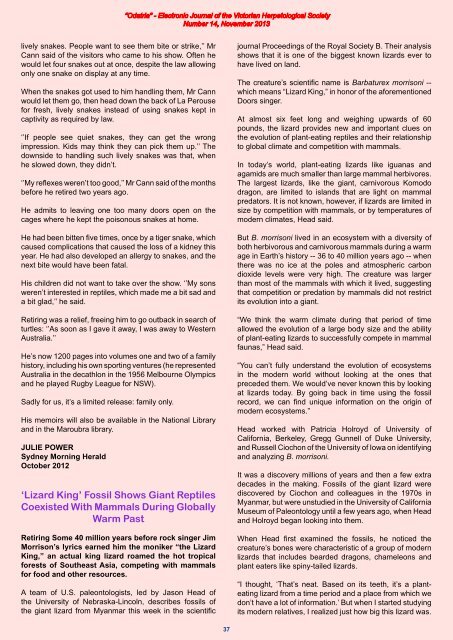Odatria_14_NOV13 - Victorian Herpetological Society
Odatria_14_NOV13 - Victorian Herpetological Society
Odatria_14_NOV13 - Victorian Herpetological Society
You also want an ePaper? Increase the reach of your titles
YUMPU automatically turns print PDFs into web optimized ePapers that Google loves.
lively snakes. People want to see them bite or strike,’’ MrCann said of the visitors who came to his show. Often hewould let four snakes out at once, despite the law allowingonly one snake on display at any time.When the snakes got used to him handling them, Mr Cannwould let them go, then head down the back of La Perousefor fresh, lively snakes instead of using snakes kept incaptivity as required by law.‘’If people see quiet snakes, they can get the wrongimpression. Kids may think they can pick them up.’’ Thedownside to handling such lively snakes was that, whenhe slowed down, they didn’t.‘’My reflexes weren’t too good,’’ Mr Cann said of the monthsbefore he retired two years ago.He admits to leaving one too many doors open on thecages where he kept the poisonous snakes at home.He had been bitten five times, once by a tiger snake, whichcaused complications that caused the loss of a kidney thisyear. He had also developed an allergy to snakes, and thenext bite would have been fatal.His children did not want to take over the show. ‘’My sonsweren’t interested in reptiles, which made me a bit sad anda bit glad,’’ he said.Retiring was a relief, freeing him to go outback in search ofturtles: ‘’As soon as I gave it away, I was away to WesternAustralia.’’He’s now 1200 pages into volumes one and two of a familyhistory, including his own sporting ventures (he representedAustralia in the decathlon in the 1956 Melbourne Olympicsand he played Rugby League for NSW).Sadly for us, it’s a limited release: family only.His memoirs will also be available in the National Libraryand in the Maroubra library.JULIE POWERSydney Morning HeraldOctober 2012‘Lizard King’ Fossil Shows Giant ReptilesCoexisted With Mammals During GloballyWarm PastRetiring Some 40 million years before rock singer JimMorrison’s lyrics earned him the moniker “the LizardKing,” an actual king lizard roamed the hot tropicalforests of Southeast Asia, competing with mammalsfor food and other resources.A team of U.S. paleontologists, led by Jason Head ofthe University of Nebraska-Lincoln, describes fossils ofthe giant lizard from Myanmar this week in the scientificjournal Proceedings of the Royal <strong>Society</strong> B. Their analysisshows that it is one of the biggest known lizards ever tohave lived on land.The creature’s scientific name is Barbaturex morrisoni --which means “Lizard King,” in honor of the aforementionedDoors singer.At almost six feet long and weighing upwards of 60pounds, the lizard provides new and important clues onthe evolution of plant-eating reptiles and their relationshipto global climate and competition with mammals.In today’s world, plant-eating lizards like iguanas andagamids are much smaller than large mammal herbivores.The largest lizards, like the giant, carnivorous Komododragon, are limited to islands that are light on mammalpredators. It is not known, however, if lizards are limited insize by competition with mammals, or by temperatures ofmodern climates, Head said.But B. morrisoni lived in an ecosystem with a diversity ofboth herbivorous and carnivorous mammals during a warmage in Earth’s history -- 36 to 40 million years ago -- whenthere was no ice at the poles and atmospheric carbondioxide levels were very high. The creature was largerthan most of the mammals with which it lived, suggestingthat competition or predation by mammals did not restrictits evolution into a giant.“We think the warm climate during that period of timeallowed the evolution of a large body size and the abilityof plant-eating lizards to successfully compete in mammalfaunas,” Head said.“You can’t fully understand the evolution of ecosystemsin the modern world without looking at the ones thatpreceded them. We would’ve never known this by lookingat lizards today. By going back in time using the fossilrecord, we can find unique information on the origin ofmodern ecosystems.”Head worked with Patricia Holroyd of University ofCalifornia, Berkeley, Gregg Gunnell of Duke University,and Russell Ciochon of the University of Iowa on identifyingand analyzing B. morrisoni.It was a discovery millions of years and then a few extradecades in the making. Fossils of the giant lizard werediscovered by Ciochon and colleagues in the 1970s inMyanmar, but were unstudied in the University of CaliforniaMuseum of Paleontology until a few years ago, when Headand Holroyd began looking into them.When Head first examined the fossils, he noticed thecreature’s bones were characteristic of a group of modernlizards that includes bearded dragons, chameleons andplant eaters like spiny-tailed lizards.“I thought, ‘That’s neat. Based on its teeth, it’s a planteatinglizard from a time period and a place from which wedon’t have a lot of information.’ But when I started studyingits modern relatives, I realized just how big this lizard was.37


